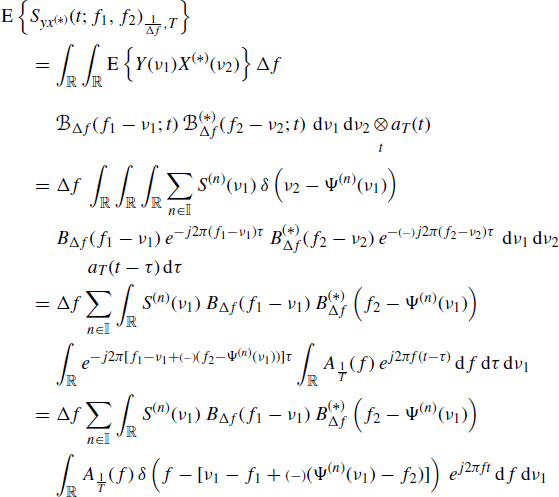5.3 Proofs for Section 4.5 “Measurement of Spectral Correlation –Unknown Support Curves”
In this section, proofs of lemmas and theorems presented in Section 4.5 on bias and covariance of the time-smoothed bifrequency cross-periodogram are reported.
Accounting for the properties of the Fourier transform of a summable function (Champeney 1990) and observing that from Assumption 4.5.2, one obtains
(5.25) ![]()
the following result can easily be proved.
Lemma 5.3.1 (Napolitano 2003, Lemma B.1). Under Assumption 4.5.2 (time-smoothing window regularity) and denoting by WA(f) the Fourier transform of ![]() , one obtains that the Fourier transform
, one obtains that the Fourier transform ![]() of the time-smoothing window aT(t) can be expressed as
of the time-smoothing window aT(t) can be expressed as
with ![]() , continuous, and infinitesimal for |f|→ ∞. Moreover, in the sense of distributions, it results that
, continuous, and infinitesimal for |f|→ ∞. Moreover, in the sense of distributions, it results that
If ![]() is continuous in t = 0, then
is continuous in t = 0, then ![]() .
. ![]()
5.3.1 Proof of Lemma 4.5.5 Expected Value of the Time-Smoothed Bifrequency Cross-Periodogram
From (4.123) and (5.6), and accounting for (4.15) and (4.107), it follows that
from which, accounting for the sampling property of the Dirac delta, (4.127) immediately follows. In the derivation of (5.28), the formal relationship (Zemanian 1987)
(5.29) ![]()
to be intended in the sense of distributions is used.
In the proof, the interchange of expectation, integral, and sum operations can be justified as in the proof of Lemma 4.4.6, accounting for the fact that ![]() (Assumption 4.5.2).
(Assumption 4.5.2).
5.3.2 Proof of Lemma 4.5.6 Covariance of the Time-Smoothed Bifrequency Cross-Periodogram
It results that (multilinearity property of cumulants (Mendel 1991))
where (4.123) has been accounted for, and the interchange of integral and expectation operations can be justified by the Fubini and Tonelli theorem (Champeney 1990). In fact, by using (4.108) into the right-hand side of (5.30) one has
where
(5.32) 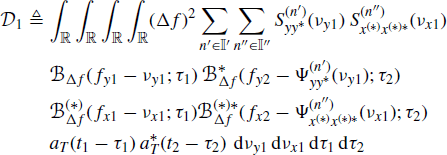
(5.33) 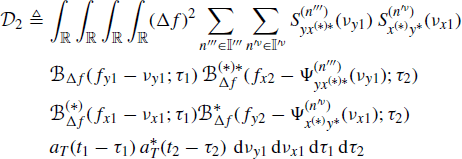
(5.34) 
Denoted by D1(νy1, νx1, τ1, τ2) the integrand function in ![]() and accounting for Assumptions 4.4.3a, 4.4.5, and 4.5.2, the result is that
and accounting for Assumptions 4.4.3a, 4.4.5, and 4.5.2, the result is that
(5.35) 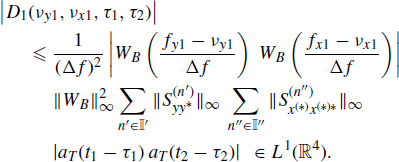
Analogously, it can be shown that the integrand function in ![]() is bounded by a summable function. Furthermore, denoted by D3(νy1, νx1, νy2, τ1, τ2) the integrand function in
is bounded by a summable function. Furthermore, denoted by D3(νy1, νx1, νy2, τ1, τ2) the integrand function in ![]() and accounting for Assumptions 4.4.3b, 4.4.5, and 4.5.2, the result is that
and accounting for Assumptions 4.4.3b, 4.4.5, and 4.5.2, the result is that
(5.36) 
By reasoning as for the derivation of (5.28), terms ![]() ,
, ![]() , and
, and ![]() can be shown to be equivalent to
can be shown to be equivalent to ![]() ,
, ![]() , and
, and ![]() , respectively. Then, (4.128) easily follows from (5.30) and (5.31).
, respectively. Then, (4.128) easily follows from (5.30) and (5.31).
Lemma 5.3.2 Let g(f) be a real-valued function of the real variable f, defined in the neighborhood of f = 0. It results that
where δf is the Kronecker delta, that is, δf = 1 if f = 0 and δf = 0 if f ≠ 0.
Proof: Let
(5.38) 
We have
if and only if
Since the function δu is discontinuous in u = 0, (5.40) is equivalent to
(5.41) ![]()
that is, in a neighborhood of Δf = 0. Thus, the limit in (5.39) is 1 if and only if h(Δf) = 1 in a neighborhood of Δf = 0, that is, if and only if g(Δf) = 0 in a neighborhood of Δf = 0.
Note that g(Δf) can be possibly discontinuous or even not defined in Δf = 0. That is, we do not require g(0) = 0. ![]()
5.3.3 Proof of Theorem 4.5.7 Asymptotic Expected Value of the Time-Smoothed Bifrequency Cross-Periodogram
By substituting (4.103) and (5.26) into the expression (4.127) of the expected value of the time-smoothed cross-periodogram, and making the variable change λ1 = (f1 − ν1)/Δf one has
Denoted by JΔf,T(λ1) the integrand function in (5.42) and accounting for (4.97), Assumption 4.4.5 and Lemma 5.3.1, the result is that
![]()
with the right-hand side independent of T and Δf. Thus, the dominated convergence theorem (Champeney 1990) can be applied:
where Lemmas 5.2.1a and 5.2.2 have been accounted for, and the interchange of limit, sum, and integral operations can be justified as in the proof of Lemma 4.4.6.
Since WA is infinitesimal at ±∞, for any finite Δf the limit for T→ ∞ is zero unless the argument of the inner large parenthesis in the last line of (5.43) is zero. Therefore, accounting for the continuity of WA(ν), it results in
where ![]() is defined in (5.37). To obtain the last equality, observe that, accounting for Lemma 5.3.2, when Δf → 0 the argument of the Kronecker delta in the second line is zero only if f2 = Ψ(n)(f1) and
is defined in (5.37). To obtain the last equality, observe that, accounting for Lemma 5.3.2, when Δf → 0 the argument of the Kronecker delta in the second line is zero only if f2 = Ψ(n)(f1) and ![]() in a neighborhood of f1.
in a neighborhood of f1.
Finally, by substituting (5.44) into (5.43), (4.132) is obtained.
5.3.4 Proof of Corollary 4.5.8
At first let us observe that, for Assumption 4.5.3 there is no cluster of support curves and, consequently, for T sufficiently large, it is finite the set ![]() of indices n such that, at the fixed point (f1, f2), it results |f2 − Ψ(n)(f1)|
of indices n such that, at the fixed point (f1, f2), it results |f2 − Ψ(n)(f1)| ![]() T−1. In addition, there exists T0 > 0 such that for T > T0 the number of elements of
T−1. In addition, there exists T0 > 0 such that for T > T0 the number of elements of ![]() does not change with T.
does not change with T.
By considering the Taylor series expansion for Ψ(n)(f1) with second-order Lagrange residual term one has
where ![]() , ξ
, ξ ![]() [0, 1]. By substituting (5.45) into
[0, 1]. By substituting (5.45) into
(5.46) ![]()
it results in
In Theorem 4.5.7, the asymptotic biasedness of the time-smoothed cross-periodogram is proved for SC processes that are not ACS. This is consequence of the fact that, when ![]() in a neighborhood of f1, the function h(n)(λ1) in (5.42) approaches zero, as T→ ∞ and Δf → 0 with TΔf→ ∞ (see (5.44)). However, if at the point (f1, f2) it results that
in a neighborhood of f1, the function h(n)(λ1) in (5.42) approaches zero, as T→ ∞ and Δf → 0 with TΔf→ ∞ (see (5.44)). However, if at the point (f1, f2) it results that
and
for all ![]() i.e., for all n such that
i.e., for all n such that
(5.50) ![]()
then in substituting (5.47) into (5.42) we can put
In fact, under Assumption 4.4.5 WB(λ1) has approximate bandwidth equal to 1, that is, it is significantly different from zero only for λ1 = O(1) (independently of T and Δf) and WA(f) is infinitesimal for |f|→ ∞. Thus, by substituting (5.51) into (5.42), for Δf sufficiently small, one obtains (4.136).
Note that (5.48) and (5.49) can be both verified if the second-order derivative of Ψ(n) is bounded (Assumption 4.5.4) and T and Δf are such that TΔf ![]() 1 and T(Δf)2
1 and T(Δf)2 ![]() 1. If the time-smoothed cross-periodogram is evaluated (with fixed T and Δf) for
1. If the time-smoothed cross-periodogram is evaluated (with fixed T and Δf) for ![]() , with
, with ![]() denoting the analysis range, then uniform boundedness in
denoting the analysis range, then uniform boundedness in ![]() of second-order derivatives
of second-order derivatives ![]() is necessary (Assumption 4.5.4).
is necessary (Assumption 4.5.4).
5.3.5 Proof of Theorem 4.5.9 Asymptotic Covariance of the Time-Smoothed Bifrequency Cross-Periodogram
By substituting (4.103) and (5.26) into (4.129) and making the variable changes λy1 = (fy1 − νy1)/Δf and λx1 = (fx1 − νx1)/Δf, one obtains
(5.52) 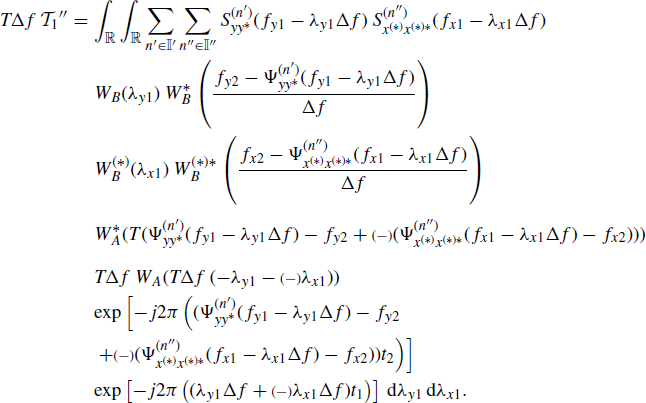
Thus, accounting for Assumption 4.4.3a and Lemma 5.3.1, one has
(5.53) 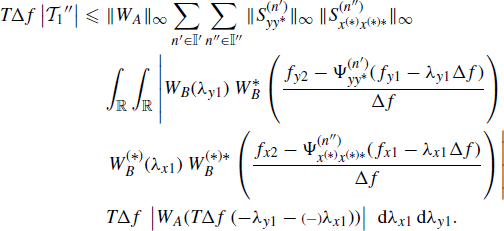
From (5.27) and for ![]() , it follows that, in the sense of distributions,
, it follows that, in the sense of distributions,
Therefore, for T→ ∞ and Δf → 0 with TΔf→ ∞, accounting for (5.13), (5.54), and the sampling property of Dirac delta, one obtains that ![]() with
with ![]() given by (4.138).
given by (4.138).
Analogously, it can be shown that
(5.55) ![]()
with ![]() given by (4.139).
given by (4.139).
Furthermore, by substituting (4.103) and (5.26) into (4.131) and making the variable changes λy1 = (fy1 − νy1)/Δf, λx1 = (fx1 − νx1)/Δf, and λy2 = (fy2 − νy2)/Δf, it results in
(5.56) 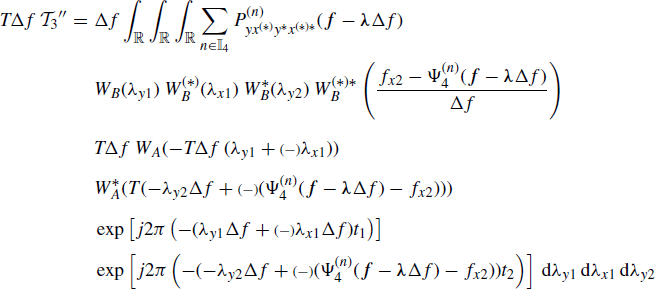
where f − λΔf ![]() [fy1 − λy1Δf, fx1 − λx1Δf, fy2 − λy2Δf]. Thus, accounting for Assumptions 4.4.3b and 4.4.5 and Lemma 5.3.1, one has
[fy1 − λy1Δf, fx1 − λx1Δf, fy2 − λy2Δf]. Thus, accounting for Assumptions 4.4.3b and 4.4.5 and Lemma 5.3.1, one has
(5.57) 
Accounting for (5.54), one obtains
(5.58) 
Therefore, for T→ ∞ and Δf → 0 with TΔf→ ∞,
(5.59) 
where the last equality holds under assumption (4.98).
As a final remark, note that the order of the two limits as Δf → 0 and T→ ∞ in Theorems 4.5.7 and 4.5.9 cannot be interchanged. In fact, in the proofs of both Theorems 4.5.7 and 4.5.9 the double limit as Δf → 0 and T→ ∞ is evaluated with TΔf→ ∞ by taking Δf finite and fixed, making T→ ∞ and after making Δf → 0. Analogous results can be obtained if Δf = O(T−a) with 0 < a < 1. However, the more restrictive condition 1/2 < a < 1 is necessary to assure T(Δf)2 → 0 as requested in Corollary 4.5.8 to guarantee (5.49).

